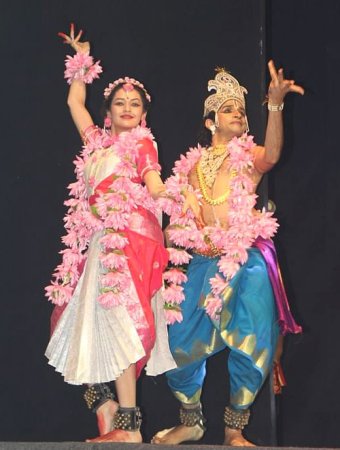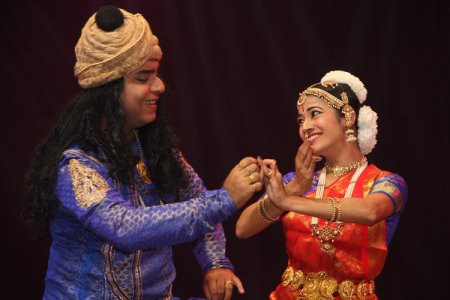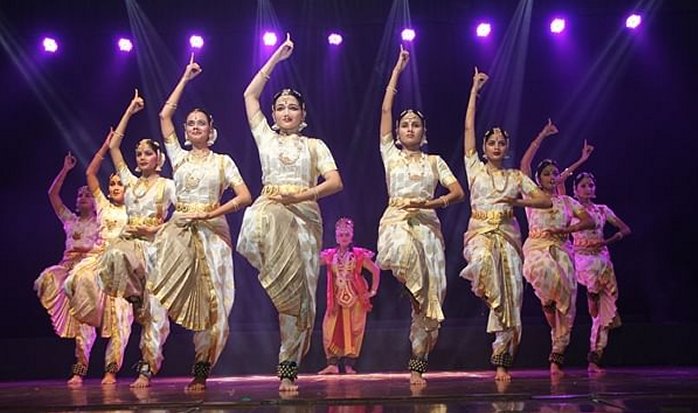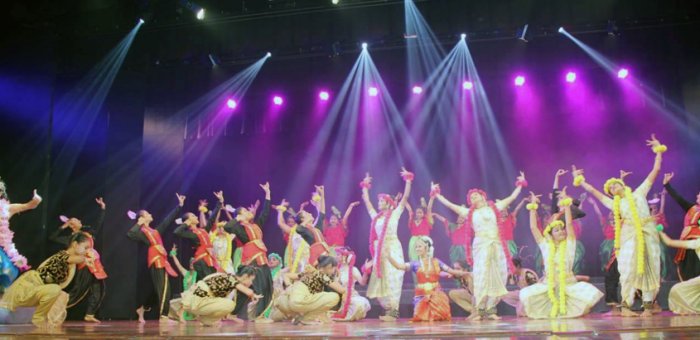
|   |

|   |
'Love in the time of Conflict'- Acharya Parvatikumar's 'Rutuchakra' - Sunil Sunkara e-mail: sunilrsunkara@gmail.com April 13, 2020 The Ritusamhara by Kalidasa has always been loved by dancers of all styles, who have been inspired both by Kalidasa's imagery and careful pampering of the king of rasas - shringara. Rutuchakra, conceived by Late Acharya Parvatikumar and brought to life by Dr. Sandhya Purecha and the students and repertory artistes of Bharata College of Fine Arts and Culture on the occasion of Acharya's birth centenary, brings the essence of Kalidasa to Maharashtra in its very own Marathi, with a special twist to the story.  Suhani Dhanki as Rati & Pavitra Bhat as Madan The whole dance production is presented around the central love story of Rati and Madan while other larger stories like the marriage of Shiva-Parvati, birth of Kartikeya and destruction of Tarakasura act as a dramatic canvas to this central eternal story of love and loss. While scholars sometimes lament on the minimalism of other rasas in the Ritusamhara, Acharya Parvatikumar treated this innovatively by bringing in each of the other rasas in the backdrop stories keeping shringara in the forefront. The tagline of the one hour program - Katha Ritunchi Rati Madanachi - kept recurring as a refrain, bringing the audience back to the central characters. One has often seen movies in Bollywood and Hollywood with the theme of love stories set to a social background of strife and battle. Rutuchakra became a real life experience of watching such a story unfold innovatively on stage with Rati portrayed by Suhani Dhanki and Madan portrayed by Pavitra Bhat, both stellar dancers from the new generation of Bharatanatyam soloists. The evening was presented by Nehru Centre, Mumbai, in a tribute to Acharya Parvatikumar for his birth centenary on Feb 27, 2020.  Karan Kishan & Chitra Dalvi The curtain opened to sculpturesque dancers wearing diaphanous veils executing karanas from the Natyashastra. Visually stunning and beautiful, it had the effect of making the audience forget their physical space and immediately enter a world of unnatural beauty. The mangalacharan elaborated on the three gunas of Satva, Tamas and Rajas as facets of Shiva. In the style of Sanskrit theatre, the dialogue opened with the Sutradhar (Kathak exponent Karan Kishan) and Nati (Bharatanatyam dancer Chitra Dalvi). The seasons which are a celebration of the five elements come to life through the union of Shiva and Parvati, which was depicted through a Kathak sequence by students of the college, where each life-giving tattva was shown coming to life. Asha Khadilkar, popular in Maharashtra for her melodious rendition of Sanskrit poetry, brought the Marathi poetry to life with the same treatment.  The premise for the evening set, we now see the pressing situation of Tarakasura (Vinod Nikam) wreaking havoc over Indra (Kailashnath Kurup) and the Devaloka, immediately after which Narada (Kuchipudi dancer Ramesh Koli) enters the court of Indra. Here, Narada tries to get hapless Indra to think of a solution. Unable to do so, Indra asks every person in his court for a suitable solution. Here an element of hasya comes in as Indra stops to question the audience members also for a solution. Reminiscent of such situations between a King and Vidushaka in Sanskrit theatre, it has the effect of both refreshing the audience as well as making them a part of the play (sadharanikarana). Here, Dr. Sandhya Purecha also effectively uses bi-focal and tri-focal scenes. As all of this was ensuing, Shiva portrayed by her senior disciple Shanti Mohanty Dave, was continuously seen mediating on one of the risers. This thus presented a stark contrast to the unfolding scenes in stage centre. Shanti, blessed natural with a gravitas filled presence on stage, aptly suited the role in a production where there were also a number of male dancers. The Sutradhar-Nati pair often occupied the riser on stage right, almost as if they were on a mattavarini from Bharata's natya mandapa continuously commenting and observing on the unfolding scene. Thus sitting in the audience, it became a very interesting perspective to see the mélange of these various parallel scenes intensifying their effect on one another. A special mention needs to be made of the Sutradhar-Nati pair who weaved in an out of each scene in perfect tandem. This leads to the grand entry of the hero-heroine of this ballad who are enjoying the season of Spring with much gusto. Here, Dr. Sandhya Purecha creates a spectacle with almost 100 dancers on stage in recreation of spring. An innovation in the aharya by costume designer Bhavna Shah was the use of simple headgear symbolic of animals, akin to puppet cutouts. The animals like deer, elephants and parrots were thus brought to life by young dancers who wove in and out of the scene. A central group of 14 Bharatanatyam dancers dressed aptly in white brocade took each sequence forward supported by the colourful cast of young supporting dancers. They thus created a neutral palate on which the colour of each season was brought through with imaginative choreography supported by props and appropriate light design. Using the refrain of 'Lalita Lavanga', a line closely associated with spring, the audience could immediately connect with the music.  Torn away from this beautiful world, Kamadeva is summoned by Indra to go break Shiva's penance, a mission he was sure would lead to his destruction. Thus spring leads to summer, where the fire of Shiva burning Kamadeva is shown to transform spring to a fiery summer. Upon finding the ashes of Kamadeva, Rati is overcome with grief. The tears of the virahini thus transform the fiery heat into a monsoon deluge. Suhani Dhanki, disciple of Dr. Sandhya Purecha, also a well known actress on Indian television, displayed fine nuanced abhinaya as Rati lamenting over the trick of fate that separated her from her love, while at the same time brought Shiva and Shakti together. The onset of Sharad is shown as the moonlight that now reminds Rati of Kamadeva and she wishes that the moon would also burn her to ashes. Hemant brings the wedding of Shiva-Parvati, where Rati seeks the blessings of Shiva, who gives her the boon of 'Saubhagyawati'. Parvati (Bijal Haria) points out the irony of the situation to Shiva. Thus begins the chain of resurrection of Kamadeva. Shishir resonated with the apparently bleak situation of a young Kartikeya waging war on Tarakasura, but hidden within that bleakness was the fulfillment of a divine prophecy of Tarakasura's destruction. With all the storylines knitted together, we reach a climax where Spring arrives once again, heralding the love of Rati-Kamadeva in a completion of the chakra of destruction and resurrection. The poetry written by Sadanand Dabir and music composition by Amit Padhye ensured that the one hour experience was an aural delight that accompanied the action packed choreography on stage.  A chemical engineer who has pursued his doctorate in biofuel research, Sunil Sunkara holds a masters degree in Kathak from Bharata College of Fine Arts and Culture, Mumbai, and Nritya Nipun from Bhatkhande Sangit Vidyapith, Lucknow. He performs regularly as well as pursues research in Kathak apart from curating dance events and regularly writing on various facets of dance through both print and online medium. |